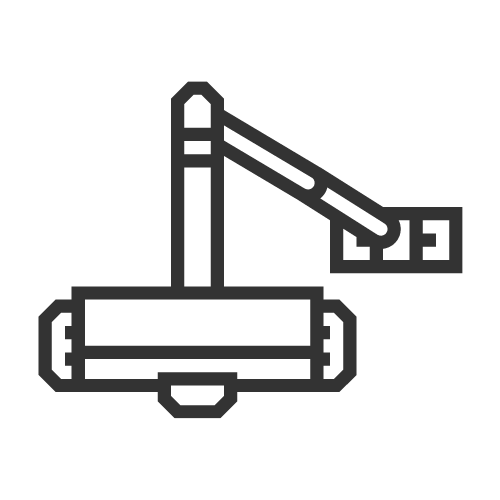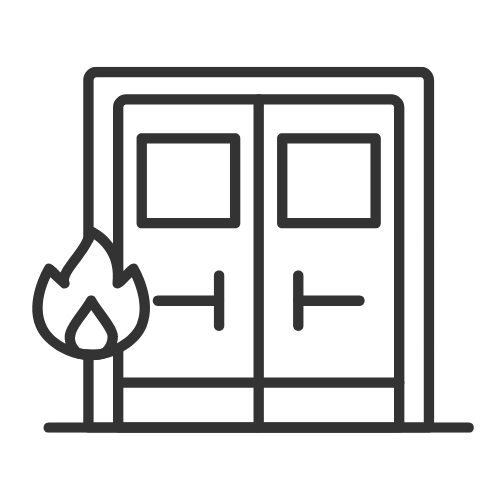Fire Doors
Key to Fire Safety and Regulatory Compliance
SURVEYS | REMEDIAL WORKS | REPLACEMENTS | INSTALLATION
Introduction to Fire Doors
Fire doors are essential components in a building’s fire protection system. Unlike standard doors, fire doors are designed to withstand fire and smoke for a set period, ensuring that the fire stays contained within a compartment and allowing occupants more time to safely evacuate. Regular inspections, proper maintenance, and timely replacements of fire doors are critical to ensuring your building meets UK fire safety regulations.
At Meritas Fire Protection, we specialise in fire door surveys, remedial works, and replacement fire doors to keep your building compliant and your occupants safe. Below, we’ll answer key questions about fire doors, how they work, and why they are crucial in ensuring fire safety.
Did you Know...
What are Fire Doors?
Fire doors are specially constructed doors designed to slow the spread of fire and smoke between compartments in a building. These doors are made from fire-resistant materials, such as timber, steel, or composite, and are fitted with intumescent seals that expand in high temperatures to block any gaps around the door, preventing smoke and fire from passing through.
Fire doors are rated based on how long they can resist fire, typically 30 minutes (FD30) or 60 minutes (FD60), depending on the building’s fire safety requirements. These ratings ensure that fire doors will hold back flames and smoke for enough time to allow safe evacuation and limit the fire’s damage.
In the UK, fire doors must comply with British Standard BS 8214 and be installed in accordance with Building Regulations Approved Document B.
Overview of Fire Doors - Regulation 10
The Fire Safety (England) Regulations 2022 require responsible persons in multi-occupied residential buildings over 11 metres to conduct quarterly checks of fire doors in common areas and annual checks of flat entrance doors. These measures, prompted by the Grenfell Tower Inquiry, ensure that fire doors function correctly, helping to prevent the spread of fire and smoke. The regulation also mandates that residents be informed about the importance of fire doors in fire safety.
Read More about the Regulations made under Article 24 of the Regulatory Reform (Fire Safety) Order 2005 visit the official fact sheet here.
Key Elements of Fire Doors

Fire-Resistant
Core
The core material of a fire door (such as timber, gypsum, or steel) is designed to withstand fire and heat for a specified period.

Intumescent
Strips
Fire doors are fitted with intumescent strips around the edges. These seals expand when exposed to heat, filling the gaps around the door to stop fire and smoke from passing through.

Auto Closing
Mechanism
Fire doors are fitted with self-closing mechanisms to ensure they are always closed when needed to block the spread of fire. They should never be propped open unless fitted with an approved hold-open device that releases when the fire alarm is triggered.

Glazed
Panels
If a fire door includes glazed panels, they are made of fire-rated glass, designed to withstand the heat of a fire for a specified period.
Why Are Fire Doors Important for Building Safety?
Fire doors play a critical role in protecting lives and limiting damage during a fire by:
- Containing Fire and Smoke: Fire doors prevent fire from spreading to other areas of a building, allowing occupants to evacuate safely and minimising structural damage.
- Protecting Escape Routes: Fire doors ensure that stairwells, corridors, and other escape routes remain smoke-free, providing a clear path for evacuation.
- Compliance with Legal Requirements: Fire doors are required by law in the UK, and failing to install or maintain them correctly can lead to fines, legal action, or worse—loss of life.
At Meritas, we provide comprehensive fire door surveys to ensure your building meets fire safety regulations and to identify any potential issues with your fire doors, including wear and tear, faulty seals, or improper installation.
Fire Door Surveys, Remedial Works, and Replacements
At Meritas Fire Protection, we specialise in all aspects of fire door maintenance, from initial surveys to remedial works and complete fire door replacements.
- Surveys - A thorough fire door survey assesses the condition of your existing fire doors to ensure they are compliant with current safety standards. Our experts inspect all components, including door frames, seals, and hardware, ensuring your fire doors provide adequate protection.
- Remedial Works - If your fire doors do not meet required standards, remedial works may be necessary. We carry out repairs, such as replacing worn seals, fixing damaged door frames, or addressing improper installations. Our goal is to ensure that your fire doors are restored to full operational capacity without needing full replacement, where possible.
- Replacements - In cases where repairs are not sufficient, replacement fire doors may be needed. We provide a range of fully compliant fire-rated doors, from FD30 to FD60, ensuring that your building remains safe and meets all fire safety regulations. We handle every stage of the process, from removing old doors to installing and certifying the new ones
Fire Doors vs Other Fire Safety Measures
While fire compartmentation focuses on dividing a building into fire-resistant sections, fire doors are vital to controlling the movement of fire and smoke between these compartments. Here’s how fire doors compare to other safety measures:
- Fire Dampers: Fire dampers prevent fire from traveling through HVAC ducts, while fire doors control the spread of fire within rooms and escape routes.
- Fire Compartmentation: Fire doors work in conjunction with compartmentation walls and floors to create a fully integrated passive fire protection system.
Both systems are essential for ensuring building safety and compliance.
Fire Door Compliance
How to Ensure Your Fire Doors Are Compliant
To ensure your building’s fire doors comply with UK regulations, follow these steps:
- Schedule Regular Inspections: Regular fire door surveys are required to ensure your doors are functioning correctly. Meritas recommends inspecting fire doors every six months.
- Repair or Replace Damaged Fire Doors: If a fire door shows signs of damage or wear, it must be repaired or replaced to ensure it functions as intended in the event of a fire.
- Ensure Correct Installation: All fire doors must be installed by certified professionals to meet safety standards and building regulations.
Meritas Fire Protection offers expert guidance, surveys, and installation services to ensure your fire doors are fully compliant and functional.
Frequently Asked Questions
A fire door is a specially designed door that can resist fire and smoke for a specified period, preventing the fire from spreading to other areas of a building.
Fire doors are made of fire-resistant materials and fitted with intumescent seals. When exposed to heat, the seals expand to block any gaps around the door, preventing smoke and fire from passing through.
Fire doors should be inspected at least every six months to ensure they are functioning properly and meet safety regulations.
Yes, fire doors are a legal requirement under Building Regulations Approved Document B, particularly in multi-occupancy buildings, commercial properties, and public buildings.
Fire doors can often be repaired if they show minor wear or damage. However, if a fire door is significantly damaged or no longer compliant, it must be replaced.

